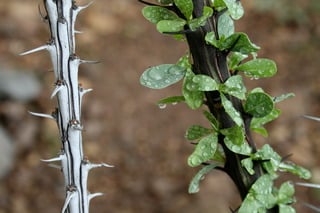Many desert plants are neither evergreen nor deciduous but are “semi-deciduous”. Learn what this means and how it helps desert plants adapt to harsh conditions.

Most trees, shrubs, and woody perennials grown in temperate climates are either evergreen (keeps its leaves all year) or deciduous (loses all its leaves for part of the year).
But in the desert southwest, there are a lot of plants that don’t neatly fall into either category. They are not exactly evergreen or deciduous — they are considered semi-deciduous.
What Is A Semi-Deciduous Plant?
Deciduous means “dropping the parts that are no longer useful”. It usually refers to plants that lose their leaves, but it doesn’t have to. (I was surprised to learn that human and puppy baby teeth are considered deciduous as well!)
Many semi-deciduous desert plants lose their leaves if the winter is cold, but will keep their leaves if the winter is mild.
Some plants lose their leaves during the summer, which can be alarming. But this doesn’t necessarily mean your plant is dying. For some desert plants, this is a normal response to extreme heat or drought. Plants that do this are also referred to as a particular kind of semi-deciduousness — drought-deciduous.
A plant can be considered semi-deciduous if it loses its leaves for a very short time or loses only some of its leaves. For example, I have a mesquite tree that loses some of its leaves after the first hard freeze, but never goes completely bare.
Here are some popular landscape plants that are considered semi-deciduous in the desert southwest:
Trees
- cat claw acacia (Senegalia greggii)
- Chilean mesquite (Prosopis chilensis)
- desert hackberry (Celtis pallida)
- ironwood (Olneya tesota)
- palo blanco (Mariosousa willardiana)
- palo verdes (Parkinsonia spp.)
Shrubs
- bougainvillea (Bougainvillea spp.)
- brittlebush (Encelia farinosa)
- chuperosa (Justicia californica)
- globe mallow (Sphaeralcea ambigua)
- little leaf cordia (Cordia parvifolia)
- plumbago (Plumbago auriculata)
- wolfberry (Lycium fremontii)
- yellow bells (Tecoma stans)
Vines
- purple orchid vine (Mascagnia lilacina)
- Queen’s wreath (Antigonon leptopus)
Ocotillo: The Ultimate Semi-Deciduous Plant
When it comes to being drought-deciduous, ocotillo (Fouquieria splendens) is in a class of its own. This unusual plant predictably leafs out once in the spring and then loses those leaves when the weather gets dry. But after a good summer rain, it will leaf out again and then later lose those leaves. It can go through this cycle four to five times during the summer, depending on the rainfall. Pretty amazing!
At the top of the article was an image of the ocotillo leaves turning color as they were about to be dropped. Here’s a look at the two stages of ocotillo side by side — both leafless and after it has leafed out.

Is Your Plant Semi-Deciduous?
If you have a plant that is losing leaves and you aren’t sure why, it may be semi-deciduous. A surprising number of desert plants use this strategy to survive their harsh environment. Before you get too concerned, determine whether this is normal for that species.
You can check if your plant is featured in our Desert Plant Library, which features comprehensive profiles of over 140 popular landscape plants (and we’re adding more all the time).
Additionally, you can download a free copy of Landscape Plants for the Arizona Desert published by the Arizona Municipal Water Users Association, a nonprofit organization. This guide provides brief overviews of over 200 low water use plants.
Semi-Deciduous vs Semi-Evergreen: What’s the Difference?
The term semi-deciduous and semi-evergreen are usually used interchangeably, but technically they are not the same thing.
In the desert, semi-deciduous plants are those that lose their leaves depending on the weather. They keep their leaves all year when conditions are right, but lose them when temperatures fall below a certain point or there is drought.
Whereas semi-evergreen refers to trees that keep their leaves throughout the winter, but then drop them in the spring as new leaves emerge. They predictably do this every year regardless of the weather. Live oak trees are one of the more common trees that do this.
Did you enjoy this article?
Sign up for our weekly newsletter
where you’ll find more great info on creating &
maintaining a beautiful, carefree desert landscape.
Author Bio
Deane Alban is the creator of Southwest Gardener. She is a science writer with a bachelor’s degree in botany from the University of South Florida. Gardening is her lifelong passion. She’s been gardening in Tucson for over 15 years.

Photo Credits
“Ocotillo (Fouquieria splendens) leaves turning red” by Joshua Tree National Park, Public Domain Mark 1.0
